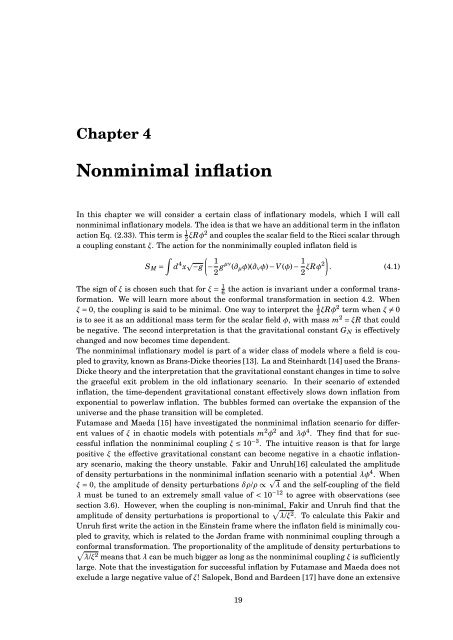Master's Thesis in Theoretical Physics - Universiteit Utrecht
Master's Thesis in Theoretical Physics - Universiteit Utrecht
Master's Thesis in Theoretical Physics - Universiteit Utrecht
You also want an ePaper? Increase the reach of your titles
YUMPU automatically turns print PDFs into web optimized ePapers that Google loves.
Chapter 4Nonm<strong>in</strong>imal <strong>in</strong>flationIn this chapter we will consider a certa<strong>in</strong> class of <strong>in</strong>flationary models, which I will callnonm<strong>in</strong>imal <strong>in</strong>flationary models. The idea is that we have an additional term <strong>in</strong> the <strong>in</strong>flatonaction Eq. (2.33). This term is 1 2 ξRφ2 and couples the scalar field to the Ricci scalar througha coupl<strong>in</strong>g constant ξ. The action for the nonm<strong>in</strong>imally coupled <strong>in</strong>flaton field is∫S M = d 4 x −g(− 1 2 gµν (∂ µ φ)(∂ ν φ) − V (φ) − 1 )2 ξRφ2 . (4.1)The sign of ξ is chosen such that for ξ = 1 6the action is <strong>in</strong>variant under a conformal transformation.We will learn more about the conformal transformation <strong>in</strong> section 4.2. Whenξ = 0, the coupl<strong>in</strong>g is said to be m<strong>in</strong>imal. One way to <strong>in</strong>terpret the 1 2 ξRφ2 term when ξ ≠ 0is to see it as an additional mass term for the scalar field φ, with mass m 2 = ξR that couldbe negative. The second <strong>in</strong>terpretation is that the gravitational constant G N is effectivelychanged and now becomes time dependent.The nonm<strong>in</strong>imal <strong>in</strong>flationary model is part of a wider class of models where a field is coupledto gravity, known as Brans-Dicke theories [13]. La and Ste<strong>in</strong>hardt [14] used the Brans-Dicke theory and the <strong>in</strong>terpretation that the gravitational constant changes <strong>in</strong> time to solvethe graceful exit problem <strong>in</strong> the old <strong>in</strong>flationary scenario. In their scenario of extended<strong>in</strong>flation, the time-dependent gravitational constant effectively slows down <strong>in</strong>flation fromexponential to powerlaw <strong>in</strong>flation. The bubbles formed can overtake the expansion of theuniverse and the phase transition will be completed.Futamase and Maeda [15] have <strong>in</strong>vestigated the nonm<strong>in</strong>imal <strong>in</strong>flation scenario for differentvalues of ξ <strong>in</strong> chaotic models with potentials m 2 φ 2 and λφ 4 . They f<strong>in</strong>d that for successful<strong>in</strong>flation the nonm<strong>in</strong>imal coupl<strong>in</strong>g ξ ≤ 10 −3 . The <strong>in</strong>tuitive reason is that for largepositive ξ the effective gravitational constant can become negative <strong>in</strong> a chaotic <strong>in</strong>flationaryscenario, mak<strong>in</strong>g the theory unstable. Fakir and Unruh[16] calculated the amplitudeof density perturbations <strong>in</strong> the nonm<strong>in</strong>imal <strong>in</strong>flation scenario with a potential λφ 4 . Whenξ = 0, the amplitude of density perturbations δρ/ρ ∝ λ and the self-coupl<strong>in</strong>g of the fieldλ must be tuned to an extremely small value of < 10 −12 to agree with observations (seesection 3.6). However, when the coupl<strong>in</strong>g is non-m<strong>in</strong>imal, Fakir and Unruh f<strong>in</strong>d that theamplitude of density perturbations is proportional to √ λ/ξ 2 . To calculate this Fakir andUnruh first write the action <strong>in</strong> the E<strong>in</strong>ste<strong>in</strong> frame where the <strong>in</strong>flaton field is m<strong>in</strong>imally coupledto gravity, which is related to the Jordan frame with nonm<strong>in</strong>imal coupl<strong>in</strong>g through aconformal √ transformation. The proportionality of the amplitude of density perturbations toλ/ξ 2 means that λ can be much bigger as long as the nonm<strong>in</strong>imal coupl<strong>in</strong>g ξ is sufficientlylarge. Note that the <strong>in</strong>vestigation for successful <strong>in</strong>flation by Futamase and Maeda does notexclude a large negative value of ξ! Salopek, Bond and Bardeen [17] have done an extensive19
















